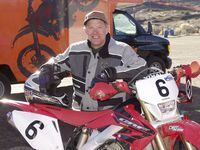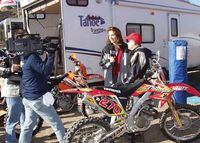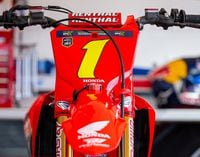Dick Burleson has been involved in off-road motorcycles just shy of five decades. And since King Richard was there at the beginning, we wanted to hear about his early years, and what he has been doing since.DR: What was your entree into the sport.
DB: Well, I didn't ride a motorcycle until I was 18. It was a Honda S90. The excuse to my parents was that I needed it for work. I worked a summer job at a water pump station near where Red Bud is today in Southern Michigan. It was my summer transportation, but of course I was going through the dunes near Lake Michigan back and forth from work. So that was my introduction to dirt bikes.DR: Did you continue riding in college or give it up for the books?
DB: At that time in the late 60's, everybody wanted to ride motorcycles. I remember even Honda's ads said, "You meet the nicest people riding Hondas." What's interesting to me is to realize that it's the same thing going on right now as when I was in High School and college - a huge boom and motorcycling is for everybody, the whole family is going out there to ride. It is a full repeat for me to watch.So yes, in college we rode all the time. There was a little scrambles area off the north side of campus. There were about 50 guys moto'ing it out every day. That was before "motocross" even existed. I got a couple of other bikes, I didn't race on the S90, and I started racing scrambles races. I seemed to be suited for it. Maybe it was my mother's genes, but I was small and fit in high school. I really took to scrambles. I got a sponsorship, rode the Trans AMA Series in 1970 and became the National Champ. This was before they had a National Motocross series.Then I got hooked up with John Penton. I was working at a motorcycle shop in Ohio for a summer job while going to college with a friend, who was an old friend of John's. So I got started in the Six-Days Enduro, because those guys were into it. At that time I was racing motocross. When I graduated from college with a degree in engineering, I went to work for Husqvarna, which by then had been bought back from Penton, but was still in Ohio. So I was in the technical department at the U.S. headquarters for Husqvarna.DR: That position was as an engineer, correct?
DB: Yes, most of the development was done in Sweden; we were reporting back what we would find out. Really I was heading up a service department. It might have been a step down for me, but I was an enthusiast. I worked for Husky for 17 years. During that time I gave up on motocross because of all the waiting around. I preferred the constant action of the Six-Days and enduros. At Husqvarna, I was promoted up to overall head of the new model specifications, warranty service and racing programs.DR: So you continued to race while working at Husqvarna?
DB: Yes. For about 10 years I was a pretty serious racer while still doing my technical work for Husky. When I stopped racing in 1981, I continued to manage the enduro team and the motocross team.DR: How did the purchase of Husqvarna by Cagiva affect you?
DB: That didn't play out well for me, so I started my own thing. I call my consulting business Dick Burleson Sports, and I've been doing that since 1988.DR: What projects have you done under that shingle?
DB: A lot of different things, like development work for KTM, or noise certification stuff or some work from Honda. One time I built the bikes for some guys that went down to South America for a 15,000-mile ride.DR: When did you start working for Moose?
DB: In 1993 I was hired by Parts Unlimited to help with the Moose Product line. I've been with them ever since. In the beginning, there was no product, so we had much to do and develop. I was heavily involved in development and testing, but now that the line of products is filled out, I'm more involved with promotion. I still do a lot with the ATV market. Moose Utility products are huge, so I've been involved with that in product development and testing. The great thing about ATV's is that you can use them 12 months a year. For people that live where the seasons change, there is no down time for their ATV use. I live in snow country and I've got a big ol' Moose snowplow on the front of mine to plow my driveway. You can drag the motocross track or go hunting with it; they're really a year-round deal. This is opposed to a snowmobile or even a motocross bike where time is limited to a couple of months a year.DR: What does the promotion side of things entail for you?
DB: I put on a big ride for the Parts Unlimited dealers in the fall, for example. I also organize showcases at Supercross and help get press coverage with the magazines or TV. That's what I've been doing for the last ten years and I love it, they are a great company to work for. And I've been working for Dirt Rider about the same amount of time as a contributing editor.DR: What do you think of this new fever for four strokes?
DB: It's funny to me. Everybody is saying, "Oh yeah, this is the new thing, four strokes in motocross." I rode a four-stroke BSA 441 with a Westlake 4 valve head on it, Mattisse frame, fiberglass, and oh, it was trick. I rode that bike in the very first motocross race there ever was - in Croton Park, Michigan. Then I rode it in the first Motocross race ever held at Unadilla, New York. So four-stroke motocross to me is "been there, done that." Of course back then, they were pretty big and really heavy.I saw the four-stroke fever coming to stay, so I started Thumper Racing with a partner. I hired Gary Hazel to manage the company and we have now sold it to him. I'm still involved in testing and development but it is his company now. They make a great bike, check them out at www.thumper-racing.net for more info.DR: Are you still actively racing now?
DB: Yes, I still do about 10 or 12 races a year in the GNCC or WORCS series or enduros. I get to pick and choose which races, which makes it really fun. For instance, there is one coming up in Maryland (Wisp GNCC) that I'm going to race because it is a really cool course.
Latest



/cloudfront-us-east-1.images.arcpublishing.com/octane/FUUS4XCVVZHYLBVJDLUGRT7RZQ.jpg)
/cloudfront-us-east-1.images.arcpublishing.com/octane/FSUTQ6NZ7RCO3M4NCBRJPKNM5M.jpg)
/cloudfront-us-east-1.images.arcpublishing.com/octane/XAZ2DGYTEJA2BE2TQ6H3KWXW4U.jpg)
/cloudfront-us-east-1.images.arcpublishing.com/octane/WC2HVBKSHNEJBODES2R5Y53VRY.jpg)
/cloudfront-us-east-1.images.arcpublishing.com/octane/JRSZS66MQBDH7O2JNMJHBQKIA4.jpg)
/cloudfront-us-east-1.images.arcpublishing.com/octane/WM3CKNM255E7NLISG3J5SOU63Y.jpg)
/cloudfront-us-east-1.images.arcpublishing.com/octane/XP5WDDR2AVGR3BF5S6TPCGYJ5A.jpg)
/cloudfront-us-east-1.images.arcpublishing.com/octane/7UAIG5GYLZH7LD72MKUYIHQYWU.jpg)
/cloudfront-us-east-1.images.arcpublishing.com/octane/6KXNSCIBK5BUNIJXUUELRO5W5Q.jpg)
/cloudfront-us-east-1.images.arcpublishing.com/octane/ZEQ7DSS7ZJCSLDAPECTSOAOGXI.jpg)
/cloudfront-us-east-1.images.arcpublishing.com/octane/OFSXJJ5PZFEZ5D5ZPMCFVHJUMA.jpg)
/cloudfront-us-east-1.images.arcpublishing.com/octane/N2JLNLG44VEKBMEPORRDTMX5A4.jpg)
/cloudfront-us-east-1.images.arcpublishing.com/octane/EOERU244ONEWVKQ7C24OHMRVWY.jpg)
/cloudfront-us-east-1.images.arcpublishing.com/octane/JF4T3ULTGNHTVEKSTNKLJ2IGKY.jpg)

/cloudfront-us-east-1.images.arcpublishing.com/octane/FAOZEEEXFVA3ZK2PYMY3DHI2EQ.jpg)
/cloudfront-us-east-1.images.arcpublishing.com/octane/WCAUGYKA5FDZTB64FM36LJFMMM.jpg)
/cloudfront-us-east-1.images.arcpublishing.com/octane/EIDVOIN5IJDMRIVS2VNTOOBVSA.jpg)
/cloudfront-us-east-1.images.arcpublishing.com/octane/5BSWCTPONFB3DJFRPJ34STZMR4.jpg)
/cloudfront-us-east-1.images.arcpublishing.com/octane/KSERUHQUTNHLBCWKXS2R3TYZHI.jpg)
/cloudfront-us-east-1.images.arcpublishing.com/octane/GGOH2AQRSVHY5C5JLNEVYLB5SU.jpg)
/cloudfront-us-east-1.images.arcpublishing.com/octane/TJJEHV3ATZFFXHUYZABHXKE2DI.jpg)
/cloudfront-us-east-1.images.arcpublishing.com/octane/M7L5LNQ5JZENHNBTCHEIKZKD24.jpg)
/cloudfront-us-east-1.images.arcpublishing.com/octane/WIC4RXQ36BAXNIW6U4UJ3XDLKI.jpg)